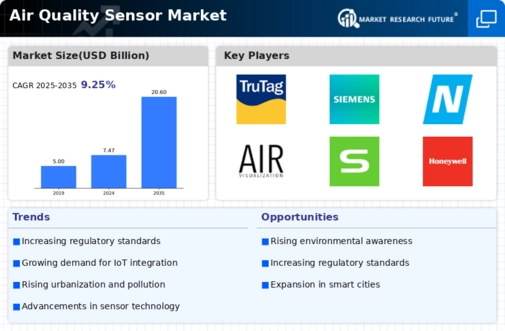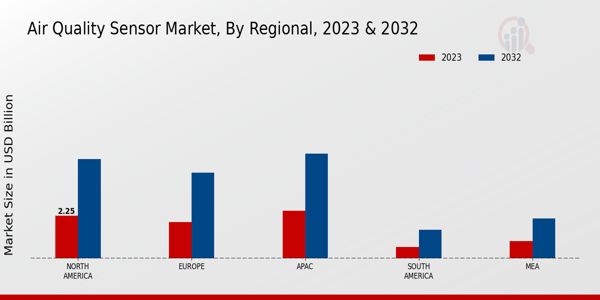Chart Representation
The following chart illustrates the projected growth trajectory of the Global Air Quality Sensor Market Industry, highlighting key milestones such as the expected market size of 7.47 USD Billion in 2024 and 20.6 USD Billion by 2035. Additionally, the chart depicts the compound annual growth rate of 9.66% anticipated from 2025 to 2035, emphasizing the increasing importance of air quality monitoring in various sectors.
Regulatory Compliance
Stringent regulations regarding air quality standards are propelling the Global Air Quality Sensor Market Industry forward. Governments worldwide are implementing policies to monitor and improve air quality, which necessitates the deployment of advanced sensor technologies. For example, the European Union has established directives mandating air quality monitoring in urban areas. Compliance with these regulations often requires municipalities and industries to invest in air quality sensors, thereby driving market growth. As a result, the market is anticipated to expand significantly, with a projected value of 20.6 USD Billion by 2035, indicating a robust response to regulatory pressures.
Increasing Urbanization
The rapid pace of urbanization globally drives the demand for air quality sensors. As cities expand, the concentration of pollutants rises, necessitating effective monitoring solutions. The Global Air Quality Sensor Market Industry is witnessing heightened interest from municipalities aiming to ensure public health and safety. For instance, urban areas are increasingly deploying sensors to track air quality in real-time, enabling timely interventions. This trend is expected to contribute to the market's growth, with projections indicating a market size of 7.47 USD Billion in 2024, reflecting the urgent need for comprehensive air quality management in densely populated regions.
Technological Advancements
Innovations in sensor technology are transforming the Global Air Quality Sensor Market Industry. The development of low-cost, high-precision sensors has made air quality monitoring more accessible to various sectors, including residential, commercial, and industrial applications. Enhanced features such as wireless connectivity and real-time data analytics are increasingly integrated into these devices, improving their functionality. This technological evolution not only broadens the market's reach but also encourages widespread adoption. As a result, the market is expected to experience a compound annual growth rate of 9.66% from 2025 to 2035, reflecting the growing reliance on advanced air quality monitoring solutions.
Public Awareness and Health Concerns
Growing public awareness regarding the health impacts of air pollution is a significant driver for the Global Air Quality Sensor Market Industry. Citizens are becoming more informed about the detrimental effects of poor air quality on health, leading to increased demand for monitoring solutions. This heightened awareness is prompting governments and organizations to invest in air quality sensors to provide transparent data to the public. Initiatives aimed at educating communities about air quality issues further fuel this demand. Consequently, the market is poised for substantial growth as stakeholders seek to address public health concerns through effective monitoring.





















Leave a Comment